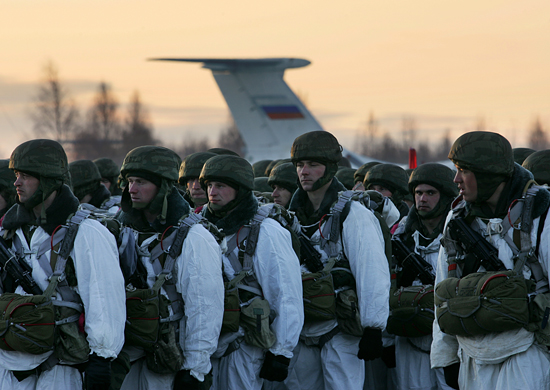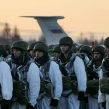
Moscow’s Confrontational Policy Turns Russia From an Ally to a Threat for Armenia
Publication: Eurasia Daily Monitor Volume: 13 Issue: 30
By:

On February 8, a number of units of Russia’s Southern Military District as well as the Black Sea Fleet and the Caspian Flotilla were put on a high alert, and massive snap exercises followed. According to Russian officials, this and similar such snap exercises would be organized during the year, in order to ready troops for a larger exercise, codenamed “Kavkaz” (Caucasus), planned for late 2016 (Gazeta.ru, February 8).
The current drill, planned to go on until February 13, will involve up to 50 naval vessels, 200 airplanes and helicopters, and nearly 8,500 personnel. Russian sources noted that the need to test the readiness of troops deployed in that region was now also affected by the tensions in relations with Turkey and the possibility of a deployment of additional North Atlantic Treaty Organization (NATO) units in the Black Sea region (Gazeta.ru, February 11).
Russian independent military experts’ views about the rationale of the current exercises are rather skeptical. In Pavel Felgenhauer’s opinion, the exercises may be related to the siege of Aleppo by the Syrian army backed by the Russian air force and a possible future escalation, perhaps even a ground operation of the Russian army in Syria (Nv.ua, February 9). He also notes the Russian military’s propensity to use military exercises as a disguise for massive troop movement in preparation for war, like happened ahead of Russia’s invasion of Georgia in 2008 and the occupation of Crimea in 2014 (see EDM, February 11). Previously, Felgenhauer has warned that practicing such snap exercises on a regular basis could result in a confrontation with NATO (Novaya Gazeta, June 6, 2015). Another Russian analyst, Alexander Golts, has also suggested that the February snap exercises could be in preparation for a large-scale operation in Syria in order to secure Russia’s relative success in Aleppo. But this could lead to a deeper confrontation with Turkey (Yezhednevnyi zhurnal, February 9). Earlier—after allegations that another Russian military aircraft had violated Turkey’s airspace, putting the Turkish air force on “orange alert” on January 31—Golts argued, in an interview with Deutsche Welle, that the possibility of a local conflict involving Russian and Turkish units could not be excluded (Deutsche Welle—Russian service, February 1).
The 102nd Russian military base in Armenia has also been involved in the recent massive snap exercises. And some Armenian analysts have repeated their warnings about Yerevan possibly being dragged directly into the Russo-Turkish confrontation (see EDM, December 11, 2015). The Russian ambassador to Armenia, Ivan Volynkin, did not exclude the possibility of using the 102nd base in a theoretical armed conflict against Turkey, suggesting that bilateral agreements regulating the status of the base allow the Russian side to make its own decisions on the matter (Lragir.am, February 9). Armenian officials mostly avoid discussions about the possibility of becoming involved in the confrontation with Turkey. The only exception to date has been a statement by Minister of Defense Seyran Ohanyan, who vaguely commented that Armenia would not stand aside in the face of regional challenges (Lragir.am, February 10).
Meanwhile, the intensity of pro-Russian propaganda in Armenia has increased, sometimes taking rather bizarre forms, such as widespread praise in the media for a proposal made by some members of the Russian State Duma to denounce the 1921 peace and friendship treaties between Russia and Turkey (Lenta.ru, February 8). Andranik Migranyan, a professor at the Moscow State Institute of International Relations (MGIMO), was recently invited to a conference in Yerevan as a keynote speaker. Migranyan, who is known for his “patriotic” (in contemporary Russian jargon) views, then proceeded to give an interview in which he declared, in a pejorative outburst, that Armenians should be happy about Russia’s anti-Turkish sentiment, instead of complaining about the possible dangers (Tert.am, February 4). The MGIMO professor’s diatribe, together with his previously expressed views, compelled some journalists to openly question the motives of those who continue to invite him to conferences in Armenia. The extreme level of Migranyan’s rhetoric could also be demonstrated by his praise of Adolf Hitler as he reprimanded opponents of the Russian occupation of Crimea in 2014 (Izvestia, April 3, 2014).
The campaign of pro-Russian propaganda currently targeting Armenia takes on many forms, including outright falsification. For example, a summary of Golts’s above-cited interview was published on an Armenian website with the addition of a provocative statement, falsely ascribed to Golts, that in the case of a further confrontation with Russia, Turkey will fall apart (Armlur.am, February 2). For analysts who follow Golts’s publications and are familiar with his professional reputation, it was almost certainly clear that he would not make such remarks. In fact, this statement about Turkey more closely matched the style of someone like fringe Russian nationalist politician Vladimir Zhirinovsky. However, many less well informed readers may easily have been misled.
Several likely explanations exist for the intensive and often extreme forms of propaganda now directed at Armenia. First of all, serious economic decline (see EDM, January 5, 2015; January 28, 2016) has stimulated domestic discussions about the future of Armenia’s relations with Russia, including questions about Russian arms supplies to Azerbaijan and, more generally, Moscow’s ambiguous role in the Karabakh conflict resolution process. The economic slowdown in Russia and the surrounding region has also raised questions about the seeming pointlessness of Armenia’s membership in the Eurasian Economic Union, the restrictions put by Russia on Armenia’s energy cooperation with Iran, and other issues. Through all this, the main Armenian political forces have retained their allegiance to Russia. But the observable attempt to use propaganda to reactivate and intensify Armenians’ negative sentiments and fears of Turkey may be trying to sustain the image of Russia as an indispensable protector of the Armenian population. Alternatively, Russia may be attempting to use the threat of an open conflict with Turkey to bolster its hold over Armenia in order to draw out more concessions from the latter. For instance, a frightened Yerevan hoping to stay out of a war with Ankara could perhaps be more conducive to allowing a Russian “peacekeeping” operation in Karabakh. And once Russia and Turkey begin engaging in future talks aimed at improving relations, Moscow might be able to use a pliant Yerevan as a bargaining chip in such negotiations by forcing Armenia to make concessions required by Turkey. In any case, Armenia’s strong dependence on Russia has now become not only a source of democratic deficit as well as of economic and demographic problems, but also a security threat for Armenia, as regional security risks continue to grow.




